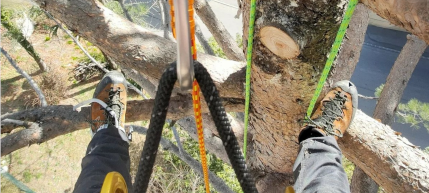Arboriculture: pruning and felling techniques for tall trees
EXPLANATION OF THE TECHNIQUE:
Derived from the words "tree" and "climb," tree climbing is a climbing technique that allows access to the canopy, or parts of, tall trees, moving safely with the aid of harnesses, ropes, and various types of specialized tools. Pruning, felling, and strengthening the tree is always a priority, always considering the well-being of the tree itself and the surrounding environment. Correctly performed interventions make the tree healthier and more vigorous, while also reducing the risk of branches falling. Last but not least, the tree appears more aesthetically ordered and balanced.

EXPLANATION OF THE INTERVENTIONS:
Containment pruning for tall trees that have grown too large in urban environments. Rejuvenation pruning for tall trees (removing deadwood, broken branches, diseased or insect-infested branches, rotting branches that provide a breeding ground for fungi and bacteria, and unnecessary plant growth that "steals" sap and nutrients from more important tree parts). Securing unsafe branches using anchors fixed within the tree's canopy; these anchors are completely harmless to the tree. Removal of the pine processionary moth (Thaumetopoea pityocampa), an insect that is highly harmful to coniferous trees as it strips them of some of their foliage, compromising their life cycle. It is also very dangerous for our four-legged friends, who risk irreparable damage to their tongues, eyes, and respiratory tract if they come into contact with this caterpillar. Also dangerous to humans, the insect's stinging hairs are poisonous and can cause a severe allergic reaction. Controlled tree-climbing is performed when it's not possible to completely fell an entire tree, for example, when space is very limited.